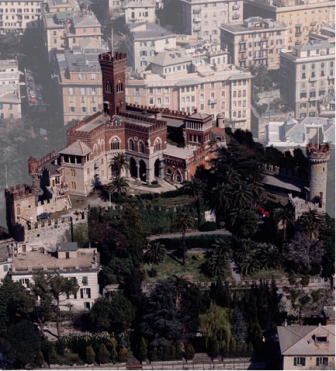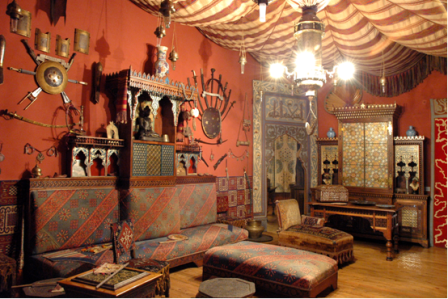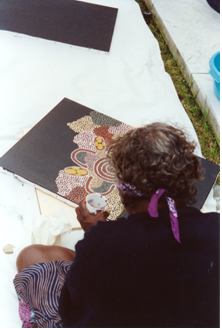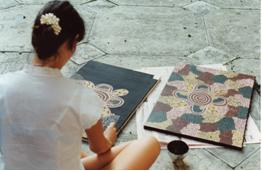Italian version: Il “Museo delle culture del Mondo di Genova” e la voce degli oggetti
Entering the garden, going up to the castle, every noise of Genova keeps quiet. I can hear just the macaia, that see me slow up to the entrance of the museum. Raised on Montegalletto Hill, originally the castle was born to be the house of the Captain Enrico Alberto D’Albertis. He offered the property of the building to Genova only in 1932, after his death. 
External view of the Castle D’Albertis
Three travels all around the world and private heirlooms are all treasured in his private apartments. From the Sala Colombiana to the Sala delle Meridiane, I walk astonished noticing the deep blue of the walls and the one of Genova’s sea admired from the terrace. Arriving in the Salotto Turco, I breath an exotic atmosphere in the semidarkness, the same exoticism that you can imagine in the end of the eighteenth Century’s salons. My imagination starts devising supple odalisques dancing ahead of the fireplace. Carrying on in the bastion of the sixteen century, I walk around the rich collections coming from Africa, America and Oceania. In this beautiful renovation, the objects don’t need any particular set up or decorations: their uniqueness recreates itself in the walls that hold them. The location is not only important to preserve the objects, but to become a part of them, in a perfect mixture.

The Turkish room
More, I discover that for the Museum of world cultures of Genova the dialog with the Indigenous Communities is a very important mission, the lifeblood of this Institution. This museum is not only holding the handworks, but it’s a meeting point for different cultural heritages. Beyond just being observed by the visitor, the objects become the middle for a dialog too. Objects are not seen only like handworks, but they represent the pieces of life that they have observed and which they have participated.
For this reason, the museum opening has been done at the hand of a Hopi community from Arizona, which had the chance to show some changing’s of their everyday life. More, the activity with the Aboriginal painter Pansy Nabanardi in 1995, where she worked with some students from the faculty of Ethnology and the school of fine art. Her story, her painting and her way of paint mixed themselves in a dialogue with the students. The exchange has been revealing and emotional, as students retrace the technical, the attires and the meanings of Pansy Aboriginal paintings. A further important occasion, the exhibition “I am Bororo”, a six year collaboration that for the first time it has been realized with the collaboration of an Indigenous community. The museum is also active in some further projects with some diverse communities that live in Genova, promoting activities with African and Latino American communities.
 |
 |
| Aboriginal painter Pansy Nabanardi | Patrizia Andriani, while she is reproducing Pansy’s painting and gestures for the exam of Pictorial Techniques of the Linguistic Academy |
To find out more about this museum, have a look at the official website: http://www.museidigenova.it
